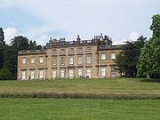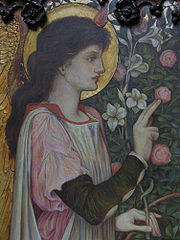
Gertrude Spencer-Stanhope
Encyclopedia
Gertrude Spencer-Stanhope (1857–1944) was an English sculptor and painter. She was the niece of John Roddam Spencer-Stanhope
and the cousin of Evelyn Pickering de Morgan
, both of whom were noted pre-Raphaelite painters.
.jpg) Mary Gertrude Elizabeth Spencer-Stanhope was the eldest of 11 children. Her mother was born Elizabeth Julia Buxton, the daughter of Sir John Jacob Buxton. Her father was Sir Walter Spencer Stanhope, who owned Cannon Hall
Mary Gertrude Elizabeth Spencer-Stanhope was the eldest of 11 children. Her mother was born Elizabeth Julia Buxton, the daughter of Sir John Jacob Buxton. Her father was Sir Walter Spencer Stanhope, who owned Cannon Hall
in Barnsley
from 1873 to 1911.
The Cannon Hall estate had been in possession of the Spencer family, and later the Spencer-Stanhopes, since 1660. In 1951 the last surviving member of the family sold the house to the Barnsley Council
. It was opened to the public as a museum in 1957. As part of its 50th anniversary celebration in 2007, Cannon Hall Museum featured 19th-century artists from the Spencer-Stanhope family in the exhibition Painters of Dreams. Bronze sculpture
s by Gertrude Spencer-Stanhope were exhibited along with paintings by John Roddam Spencer-Stanhope and Evelyn de Morgan, and ceramics by William de Morgan
, Evelyn's husband. Also highlighted were the ballroom
at Cannon Hall and "Fairyland" in the pleasure grounds, which had been designed by Sir Walter and Gertrude's sister Cecily. Painters of Dreams ran from May 23 to September 9, 2007.
 Gertrude Spencer-Stanhope exhibited paintings during the period 1886–1909 at both provincial and London galleries, but these works are not now well-known.
Gertrude Spencer-Stanhope exhibited paintings during the period 1886–1909 at both provincial and London galleries, but these works are not now well-known.
She produced perhaps only three bronze sculptures. In early 2006, the bronzes entered public ownership as part of the Museums, Libraries and Archives Council
's Acceptance in Lieu
program, which allows art
and heritage
objects to satisfy inheritance tax
in the UK
. The three — a female nude, a Pan
(on view online and archived), and a lyre
-playing Orpheus
— were allocated to Barnsley Metropolitan Borough Council
for display at Cannon Hall Museum. The works are regarded as "fine examples of the small-scale domestic bronze that was popular in late 19th century Britain," and are notable also because women rarely had the opportunity to work as sculptors at the time.
Spencer-Stanhope is also thought to have been the artist who painted the panels
for the pulpit
in Christ Church, Isle of Dogs
. The work shows the influence of her uncle's pulpit panels in St. James the Great Church, Flockton
, Wakefield
; two panels appear to be imitations, with the third taking a more definably original approach. (The painted mural
over the chancel
arch is tentatively credited to John Roddam.) Gertrude had given the pulpit, installed in 1907, in memory of her brother Edward, but the particular connection of the Spencer-Stanhope family to Christ Church is unknown.
John Roddam Spencer Stanhope
John Roddam Spencer-Stanhope is an English artist associated with Edward Burne-Jones and George Frederic Watts and often regarded as a second-wave pre-Raphaelite. His work is also studied within the context of Aestheticism and British Symbolism. As a painter, Stanhope worked in oil, watercolor,...
and the cousin of Evelyn Pickering de Morgan
Evelyn De Morgan
Evelyn De Morgan was an English Pre-Raphaelite painter.She was born Evelyn Pickering. Her parents were of upper middle class. Her father was Percival Pickering QC, the Recorder of Pontefract...
, both of whom were noted pre-Raphaelite painters.
Life and career
.jpg)
Cannon Hall
Cannon Hall is a country house museum located between the villages of Cawthorne and High Hoyland north of Barnsley, South Yorkshire, England. Originally the home of the Spencer and later the Spencer-Stanhope family, it now houses collections of fine furniture, paintings, ceramics and glassware...
in Barnsley
Barnsley
Barnsley is a town in South Yorkshire, England. It lies on the River Dearne, north of the city of Sheffield, south of Leeds and west of Doncaster. Barnsley is surrounded by several smaller settlements which together form the Metropolitan Borough of Barnsley, of which Barnsley is the largest and...
from 1873 to 1911.
The Cannon Hall estate had been in possession of the Spencer family, and later the Spencer-Stanhopes, since 1660. In 1951 the last surviving member of the family sold the house to the Barnsley Council
Metropolitan Borough of Barnsley
The Metropolitan Borough of Barnsley is a metropolitan borough of the metropolitan county of South Yorkshire, England. Its main town is Barnsley....
. It was opened to the public as a museum in 1957. As part of its 50th anniversary celebration in 2007, Cannon Hall Museum featured 19th-century artists from the Spencer-Stanhope family in the exhibition Painters of Dreams. Bronze sculpture
Bronze sculpture
Bronze is the most popular metal for cast metal sculptures; a cast bronze sculpture is often called simply a "bronze".Common bronze alloys have the unusual and desirable property of expanding slightly just before they set, thus filling the finest details of a mold. Then, as the bronze cools, it...
s by Gertrude Spencer-Stanhope were exhibited along with paintings by John Roddam Spencer-Stanhope and Evelyn de Morgan, and ceramics by William de Morgan
William De Morgan
William Frend De Morgan was an English potter and tile designer. A lifelong friend of William Morris, he designed tiles, stained glass and furniture for Morris & Co. from 1863 to 1872. His tiles are often based on medieval designs or Persian patterns, and he experimented with innovative glazes and...
, Evelyn's husband. Also highlighted were the ballroom
Ballroom
A ballroom is a large room inside a building, the designated purpose of which is holding formal dances called balls. Traditionally, most balls were held in private residences; many mansions contain one or more ballrooms...
at Cannon Hall and "Fairyland" in the pleasure grounds, which had been designed by Sir Walter and Gertrude's sister Cecily. Painters of Dreams ran from May 23 to September 9, 2007.
Works

She produced perhaps only three bronze sculptures. In early 2006, the bronzes entered public ownership as part of the Museums, Libraries and Archives Council
Museums, Libraries and Archives Council
The Museums, Libraries and Archives Council is a non-departmental public body in England and a registered charity with a remit to promote improvement and innovation in the area of museums, libraries and archives...
's Acceptance in Lieu
Acceptance in Lieu
Acceptance in Lieu is a provision in British tax law under which Inheritance Tax debts can be written off in exchange for the acquisition of objects of national importance...
program, which allows art
Work of art
A work of art, artwork, art piece, or art object is an aesthetic item or artistic creation.The term "a work of art" can apply to:*an example of fine art, such as a painting or sculpture*a fine work of architecture or landscape design...
and heritage
Cultural heritage
Cultural heritage is the legacy of physical artifacts and intangible attributes of a group or society that are inherited from past generations, maintained in the present and bestowed for the benefit of future generations...
objects to satisfy inheritance tax
Inheritance Tax (United Kingdom)
In the United Kingdom, Inheritance Tax is a transfer tax. It was introduced with effect from 18 March 1986 replacing Capital Transfer Tax.-History:...
in the UK
United Kingdom
The United Kingdom of Great Britain and Northern IrelandIn the United Kingdom and Dependencies, other languages have been officially recognised as legitimate autochthonous languages under the European Charter for Regional or Minority Languages...
. The three — a female nude, a Pan
Pan (mythology)
Pan , in Greek religion and mythology, is the god of the wild, shepherds and flocks, nature, of mountain wilds, hunting and rustic music, as well as the companion of the nymphs. His name originates within the Greek language, from the word paein , meaning "to pasture." He has the hindquarters, legs,...
(on view online and archived), and a lyre
Lyre
The lyre is a stringed musical instrument known for its use in Greek classical antiquity and later. The word comes from the Greek "λύρα" and the earliest reference to the word is the Mycenaean Greek ru-ra-ta-e, meaning "lyrists", written in Linear B syllabic script...
-playing Orpheus
Orpheus
Orpheus was a legendary musician, poet, and prophet in ancient Greek religion and myth. The major stories about him are centered on his ability to charm all living things and even stones with his music; his attempt to retrieve his wife from the underworld; and his death at the hands of those who...
— were allocated to Barnsley Metropolitan Borough Council
Metropolitan Borough of Barnsley
The Metropolitan Borough of Barnsley is a metropolitan borough of the metropolitan county of South Yorkshire, England. Its main town is Barnsley....
for display at Cannon Hall Museum. The works are regarded as "fine examples of the small-scale domestic bronze that was popular in late 19th century Britain," and are notable also because women rarely had the opportunity to work as sculptors at the time.
Spencer-Stanhope is also thought to have been the artist who painted the panels
Panel painting
A panel painting is a painting made on a flat panel made of wood, either a single piece, or a number of pieces joined together. Until canvas became the more popular support medium in the 16th century, it was the normal form of support for a painting not on a wall or vellum, which was used for...
for the pulpit
Pulpit
Pulpit is a speakers' stand in a church. In many Christian churches, there are two speakers' stands at the front of the church. Typically, the one on the left is called the pulpit...
in Christ Church, Isle of Dogs
Isle of Dogs
The Isle of Dogs is a former island in the East End of London that is bounded on three sides by one of the largest meanders in the River Thames.-Etymology:...
. The work shows the influence of her uncle's pulpit panels in St. James the Great Church, Flockton
Flockton
Flockton is a village in the Kirklees district of West Yorkshire, England halfway between Huddersfield and Wakefield with a population of 1,410 ....
, Wakefield
Wakefield
Wakefield is the main settlement and administrative centre of the City of Wakefield, a metropolitan district of West Yorkshire, England. Located by the River Calder on the eastern edge of the Pennines, the urban area is and had a population of 76,886 in 2001....
; two panels appear to be imitations, with the third taking a more definably original approach. (The painted mural
Mural
A mural is any piece of artwork painted or applied directly on a wall, ceiling or other large permanent surface. A particularly distinguishing characteristic of mural painting is that the architectural elements of the given space are harmoniously incorporated into the picture.-History:Murals of...
over the chancel
Chancel
In church architecture, the chancel is the space around the altar in the sanctuary at the liturgical east end of a traditional Christian church building...
arch is tentatively credited to John Roddam.) Gertrude had given the pulpit, installed in 1907, in memory of her brother Edward, but the particular connection of the Spencer-Stanhope family to Christ Church is unknown.

